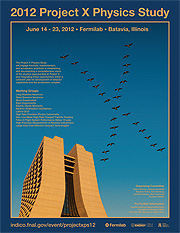Project X workshop to develop future experiment framework
 |
The Project X Physics Study at Fermilab runs through June 23. |
From June 14 to 23, the Project X Physics Study, hosted at Fermilab, will put particle physicists from around the United States and the globe to work on strategizing their future experiments using Fermilab's planned multi-megawatt proton facility, Project X.
Project X is currently a three-stage project that will produce the most intense proton beams in the world. As the flagship endeavor of the Intensity Frontier, where Fermilab hopes to focus most of its future experiments, Project X would enhance currently planned experiments using neutrinos, muons and kaons and create possibilities for new studies.
But before that can happen, the Project X team needs to develop a plan they can present at next year's Snowmass conference, a meeting of members of the high-energy physics community hosted by the American Physical Society Division of Particles and Fields. That is the goal of this workshop, said Project X scientist and workshop co-chair Bob Tschirhart.
"We want to provide a 'cookbook' of experiments for Snowmass," Tschirhart said.
That cookbook would involve knowing what experiments scientists want to do, what materials they would need, what methods they would have to develop and the associated price tag of the entire experiment.
After the first two days of plenary sessions, the team of about 150 visiting scientists will divide into two main groups. One group's task is to explore what experimental opportunities are available, and the other's is to determine what detector technologies would be necessary for those opportunities.
"It's an exploration of what Project X can do and how it relates back to the big questions we're trying to answer in particle physics," said Project X manager and workshop co-chair Steve Holmes.
Construction on the first phase of Project X could begin in the latter half of the decade, but the workshop will explore all three phases. When completed, Project X would include a continuous-wave superconducting accelerator and a pulsed accelerator to be integrated into the existing accelerator complex.
A public wine and cheese seminar will take place today at 4 p.m., with Holmes presenting the overall Project X plan. Next Friday, Tschirhart and the workshop attendees will present their work in a second public wine and cheese seminar.
—Joseph Piergrossi
|